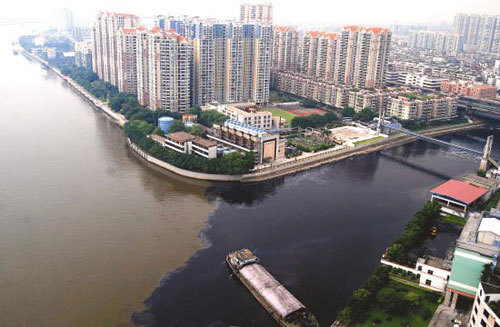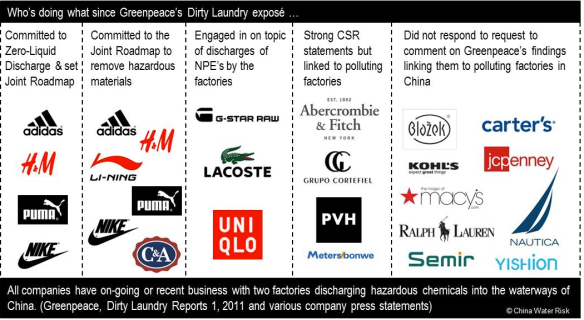Made In China. Textiles and its Environmental Impact in China.
It is estimated that China makes ¼ of the worlds clothing . The processes employed to manufacture textiles is often dangerous to humans and the environment. The problem of environmental damage is not unique to China of course but with more and more of our clothing being produced there what impact is it having on the environment and on the human population? What steps, if any, are being taken to reduce the damage ?
One of the countries greatest environmental challenges is water pollution. The World Health Organisation estimates that polluted water causes 75 percent of diseases in China.
According to World Economic Forum on East Asia, Security and Sustainability China uses three times more energy than the global average, four times more than the USA and eight times more than Japan. Pollution is endemic; four hundred thousand Chinese die prematurely every year through air pollution and in addition, all China is chronically short of water.Textile production uses large quantities of water and energy.
Environmental Impacts of Textile Processing Together with the chemicals industry, textile manufacturing is one of the largest polluting sectors in China. In general, textile processing has a very high consumption of water and energy, and a large amount of wastewater discharge.
Chemicals
25% of chemicals produced worldwide are used for textiles
Water
Growing cotton: 8,000 – 40,000 liters / 1 kg cotton Finishing of textiles: up to 700 liters of freshwater / 1 kg textile Wastewater in production: up to 600 liters / 1 kg textile
Source: Bluesign Technologies, AFIRM RSL Seminar presentation, September 27, 2007.
Chemically saturated and toxic wastewater is what makes the textile industry so environmentally damaging. Instead of recycling the wastewater many dye houses build pipes which dump the potentially toxic byproducts directly into rivers and lakes. There is a saying in China that if you want to know what colours are currently in fashion all you need to do is look at the rivers.
 Indigo dye discharged into the Pearl River.
Indigo dye discharged into the Pearl River.
Only ten percent of dyes are recycled. Treating contaminated water can cost over 13 cents per metric ton. The incentive to abide by environmental policies is diminished because of economic developmental incentives. As a result of 3 decades of economic boom 70% of China’s waters are polluted.
What steps are being taken to help solve the problem?
For global brands and retailers that source finished products from Guangdong Province, the management of wastewater is a fundamental aspect of responsible supply chain management. When apparel and textile factories release untreated or insufficiently treated wastewater into the environment, the media and consumers have historically focused on the global brands that contract with those factories, rather than on the factories themselves. And in many cases, these brands are the best placed to bring about change. For these global brands, water management – which in this case refers to conservation, usage efficiency and recycling, wastewater treatment and discharge – is one area of their supply chains where they can exert a fair amount of control and influence. Source: Bluesign Technologies, AFIRM RSL Seminar presentation, September 27, 2007.
Major brands using the factories causing the environmental damage are being named and shamed in the media and encouraged to exert pressure on the factories to change their polluting ways. Greenpeace has recently listed some high profile brand names including Nike, H&M and Lacoste in its report “Dirty Laundry”. It is important for a brand to protect its image and reputation and so there have been some commitments to improvements.
Dirty Laundry Part II
Further investigations by Greenpeace revealed that shoppers around the world are buying contaminated clothing and unwittingly spreading water pollution when they wash their new garments. Of the 78 articles analysed for Greenpeace’s Dirty Laundry 2 report, 52 tested positive for the presence of Nonylphenol ethoxylates (NPEs) above the detection limit of 1 milligram NPE per kilogram of material (mg/kg). Clothing from all but one of the fifteen brands tested (GAP, two samples) contained NPEs above the detection limit. The clothes sampled were purchased from shops in eighteen countries.
These results demonstrate both the use of these chemicals in production and the consequent toxic discharges into waterways and rivers well beyond the country of manufacture. The problem and the solution are therefore not just local concerns. This is a truly global issue
The Chinese textile industry is under close scrutiny as consumers become aware of the environmental disasters connected with the products they buy and are demanding more eco- friendly goods. Let’s hope they deliver but I wouldn’t hold your breath!

Pingback: Fung Shui – modern | 7 Years in Hong Kong
This is the new fung shui!